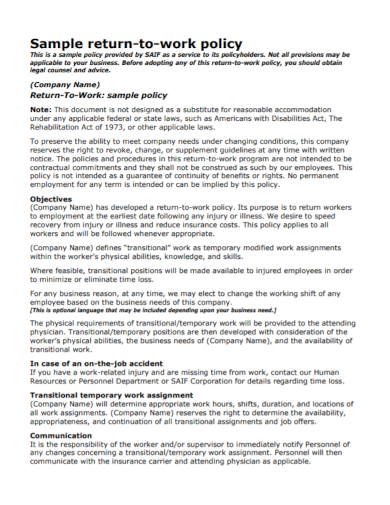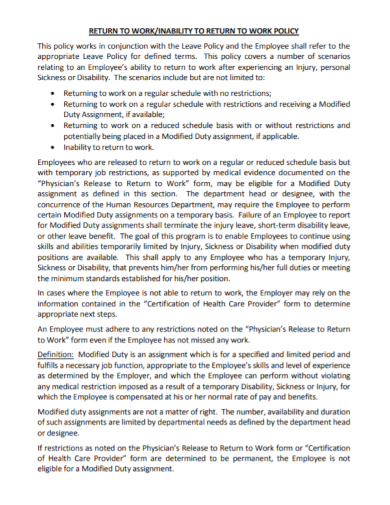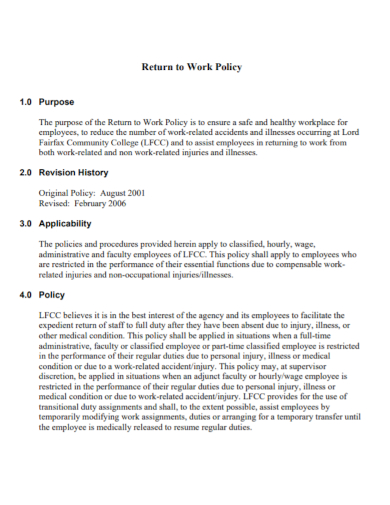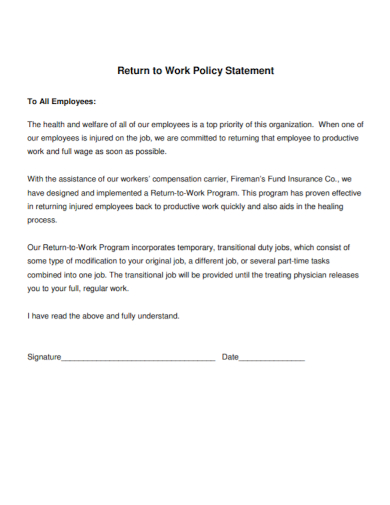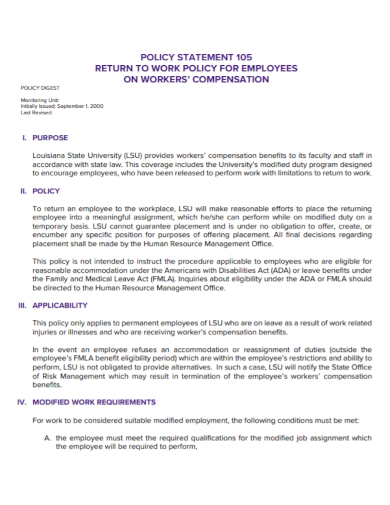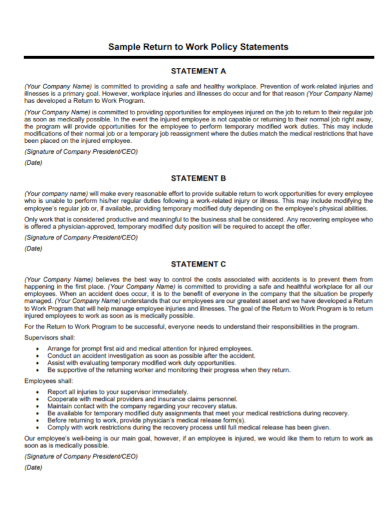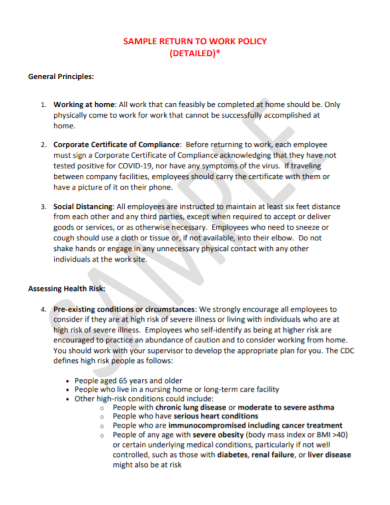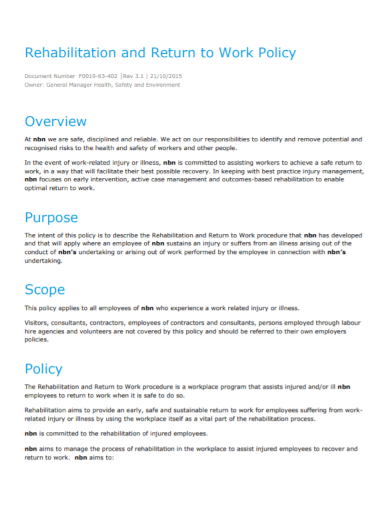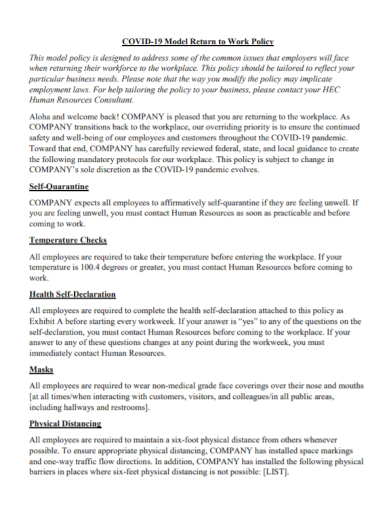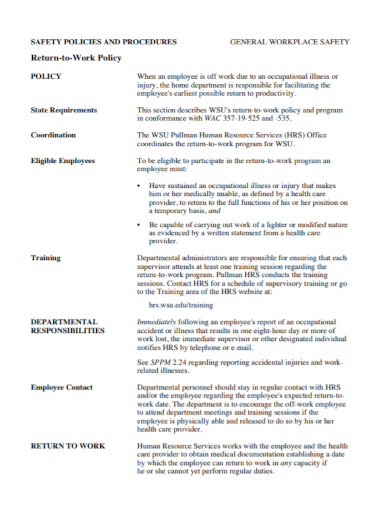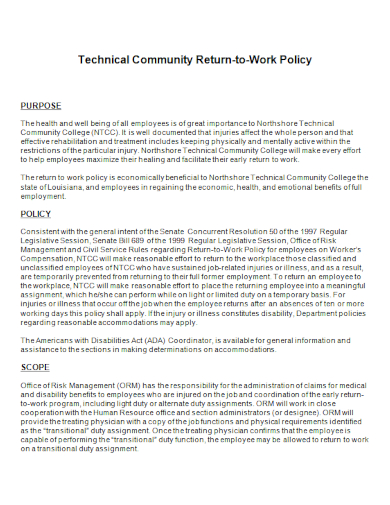There are unfortunate instances when an employee encounters a work related accident or has contracted an illness and he or she are unable to report to work. After recuperating, employers assist employees to return to work the earliest time available. In order to follow the right procedures and guidelines, companies often draft a Return to Work Policy. This is to help an employee get back to work and re-integrated within their team efficiently. To know more about this, continue reading this article and check out below our free Return to Work Policy Samples below:
10+ Return to Work Policy Samples
1. Return to Work Policy
2. Inability Return to Work Policy
3. Standard Return to Work Policy
4. Return to Work Policy Statement
5. Workers Compensation Return to Work Policy
6. Sample Return to Work Policy Statement
7. Printable Return to Work Policy
8. Rehabilitation Return to Work Policy
9. COVID-19 Return to Work Policy
10. Return to Work Safety Policy
11. Technical Community Return to Work Policy
What Is a Return to Work Policy?
Whenever you have an injured employee, lets say he acquired it while lifting boxes in a company’s warehouse or she slipped while doing an errand requested by the manager, there are instances that the recovering process does not happen too quickly. To be able to help an employee get reacquainted with his or her work whilst trying to slowly get over his or her illness, these guidelines are defined in a policy. A Return To Work Policy or RTW is a formal policy that outlines procedures that helps an employee get back to work, usually by assigning them a lighter job as they slowly recover. A return-to-work policy is designed to help injured or sick employees get back to work in a safely without compromising their health.
How to Formulate a Return to Work Policy?
In an average working day employees are often still expose to variety of hazards that can lead to injuries in the office or on the job. Despite health and safety protocols or the risk action plans a company has implemented, these unfortunate work incidents are unavoidable and are likely to happen again. Although compensation is offered to employees, a return to work program is feasible choice to limit the cost an employer incurs and aid employees get reorganized. RTW policies may vary from industry to industry, so it is important to consider the nature of the work and the specific needs of the company. Here are steps can serve as a guide to creating a successful program:
1. Statement
As you start drafting a RTW policy start with a statement to help identify the guiding principles or what is to be done. The statements are designed to influence and determine decisions and actions within the scope of coverage. This would aid management and employees understand the expectations and the basics of the process.
2. Applicability
State in your policy the scope in which your employee is applicable to avail of the return to work program. Should this apply to not only to full waged employees but to part timers as well? And what classification of injuries or illness are applicable to the RTW program.
3. Transitional Work
Identify what type of work should a returning employee should be tasked to do as long as it falls within his or her physical capabilities as not to jeopardize any health or safety issues. Here are several transitional work that could be offered to an employee:
- Alternative Work: This is a task that is offered aside from his usual or regular work, it may be a light and less strenuous to readjust to an employee’s work restriction.
- Modified Work: This consist of changing, transferring or eliminating specific job duties within the employee’s regular job to meet the temporary work restrictions.
4. Establish Procedures
Formulate a process and procedures on how to go about the RTW program, such as identify any persons in charge, if there is a need for any medical back up, list of preplanned transitional work with an outline of the physical requirements of each job and the tasks involved.
5. Monitor
As you set the policy in motion, always monitor any progress of your employee and try to observe if there are any performance related challenges incurred while at work. With this you can help assign or propose a different task for your employees.
FAQs
What Is a Worker’s Compensation?
A Worker’s Compensation or Employee Compensation is an insurance given by a company that covers medical expenses, rehabilitation and providing wage replacement within a given period.
What Is a Light Duty?
This refers to work that involves less physical activity, it is physically or mentally less demanding than normal job duties. Light Duty are often assigned to employees who are under the return to work program.
What Is the Purpose of a Company Handbook?
A Company Handbook or Employee Manual contains the detailed information related to the organization’s history, mission, values, policies, procedures and benefits in a written format.
Ultimately, bringing back an injured worker may not be an easy task, but the financial benefits can be significant such as reducing the cost of hiring a temporary employee or preventing burn-out of another employee. Perhaps more importantly, it will also benefit the physical and mental health of your employee.
Related Posts
Essential Tips to Create an Event Program
FREE 21+ Work Letter Samples
FREE 10+ Sample Medical Clearance Forms
FREE 9+ Sample Physician Release Forms
FREE 8+ Sample Refund Policy
FREE 6+ Sample Graduation Programs
FREE 6+ Church Program Templates
FREE 6+ Sample Event Program
FREE 5+ Audit Program Templates
How to Create a Successful Affiliate Marketing Program?
Crucial Steps to Start a Successful Affiliate Marketing Program
How to Design Wedding Program Template?
How to Write a Funeral Program Obituary?
FREE 12+ Job Profile Samples
FREE 10+ Memorial Program Templates

